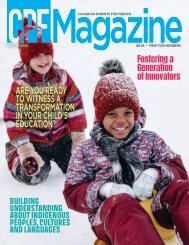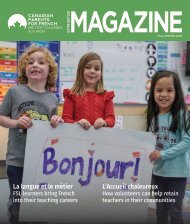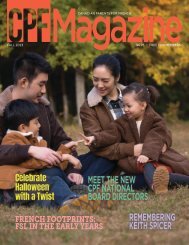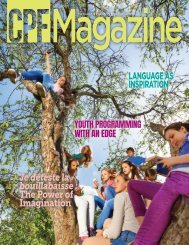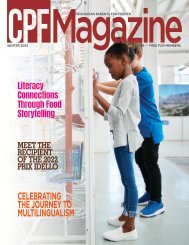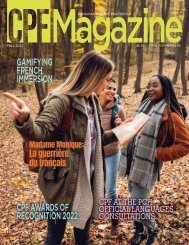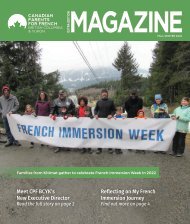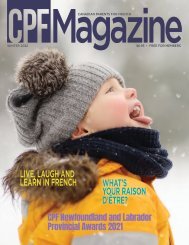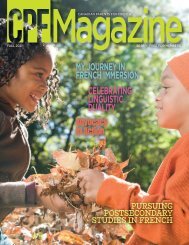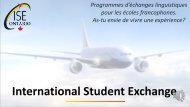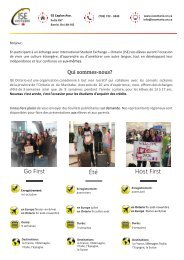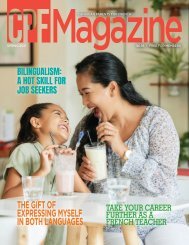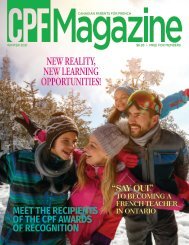CPF Magazine Winter 2020 Issue
A national network of volunteers, parents and stakeholders who value French as an integral part of Canada. CPF Magazine is dedicated to the promotion and creation of French-second-language learning opportunities for young Canadians.
A national network of volunteers, parents and stakeholders who value French as an integral part of Canada. CPF Magazine is dedicated to the promotion and creation of French-second-language learning opportunities for young Canadians.
Create successful ePaper yourself
Turn your PDF publications into a flip-book with our unique Google optimized e-Paper software.
In my interviews with parents, I’ve found myself surprised by<br />
parents’ expressions of appreciation that the school affirmed to<br />
their child the value of their family’s home language and culture<br />
through MPBL. The sense that has emerged is that MPBL builds<br />
reciprocal relationships among teachers and families. One mother,<br />
for example, who had compared trying to get her daughter to<br />
learn Farsi to forcing her to eat her vegetables, recounted:<br />
“[My daughters] weren’t curious about this ‘other’ language<br />
for a long time and the writing the translation in Farsi was a<br />
good thing and [my daughter] was happy that I could actually<br />
do it for her… it kind of opened up the door a little bit. Like<br />
she now thinks she’s more interested in the language.”<br />
When schools affirm students’ home languages and cultures,<br />
parents become language and literacy experts in the eyes of their<br />
children, and multilingual parents are empowered to actively<br />
participate in their child’s learning at school and at home.<br />
Another parent further explained how valuable it is for parents<br />
to have their children’s home languages affirmed by the school:<br />
“ I think the project has been good for [my daughter] because I<br />
think sometimes you need to mirror back to a child what they<br />
have… It hasn’t been apparent to them as a gift possibly and<br />
so having the school… pay attention to that is a way of saying<br />
to them, ‘You guys have gifts! [It’s] a really lucky thing that you<br />
have access to another language!’ It’s also powerful when it<br />
comes from teachers… As a parent when you hold the mirror up<br />
to your child to say, ‘This is the wonderful gifted person I see you<br />
are,’ it’s like, ‘Whatever, Mom.’ I think [kids] dismiss it. I think<br />
they’re pleased on one level but you as a parent sometimes<br />
don’t have as much weight. But when an external person<br />
validates that, it gives them a level of thoughtfulness about<br />
themselves that they don’t necessarily get when it’s just a<br />
parent mirroring back… When it’s valued elsewhere it’s a<br />
solid reinforcement!”<br />
My current research investigates MPBL as a school-wide<br />
strategy for building multilingual language awareness and<br />
intercultural understanding with a local elementary school in<br />
Madison, Wisconsin. In this work, parents’ reflections about<br />
their children’s collaborative multilingual work continue to<br />
affirm that teachers and parents must be partners in raising<br />
children to become thoughtfully engaged citizens in our diverse<br />
world. In closing, listen to the responses of parents following<br />
the creation of multilingual class books with five Grade 1<br />
classes as part of a science unit about plants:<br />
“I was so pleased with the book I was almost brought to tears.<br />
Particularly considering the xenophobia in our culture today, it’s<br />
a wonderful way to promote the inclusion of different languages<br />
and cultures. Thank you!”<br />
“I think it was great to have [children] working on something together.<br />
This book is definitely something we will keep and reflect back on and<br />
share with other family members.”<br />
“We wished we could have contributed with a foreign language of<br />
our own! [ Our son] can recognize the different languages (mostly)<br />
on sight. He was very proud of being able to say a few sentences<br />
in Arabic.”<br />
“My sense is that seeing… languages together in the book gives<br />
children the visual reminder of other classmates’ perspective. This<br />
project seems original, creative and useful!”<br />
Around the world where racial, linguistic, religious and political<br />
differences threaten to divide communities, the need to build bridges<br />
among teachers, students and families from diverse backgrounds is<br />
critical. Affirming and leveraging students’ cultural and linguistic assets<br />
helps move towards building more inclusive schools and gives students<br />
an opportunity to learn how to work together across their differences,<br />
within the microcosm of their classrooms. n<br />
This parent’s reflection highlights that MPBL can forge<br />
mutually beneficial relationships among teachers, students<br />
and parents that multiply opportunities to affirm children’s<br />
identities as they integrate creatively their home and school<br />
language and literacy practices.<br />
[1] J. Cummins and M. Early, Identity Texts: The collaborative creation of power in multilingual schools (London: Trentham, 2001).<br />
[2] This research was generously supported by a Joseph Armand-Bombardier Canada Graduate scholarship (2010-2013) from the Social Sciences & Humanities Research Council.<br />
<strong>CPF</strong> MAGAZINE WINTER <strong>2020</strong> 9



